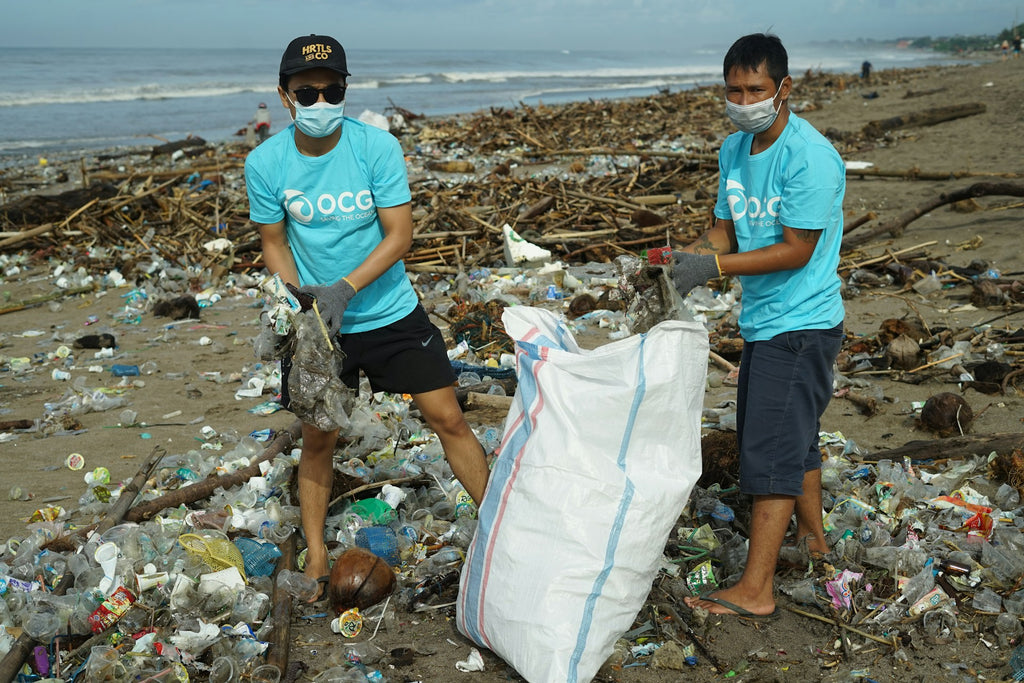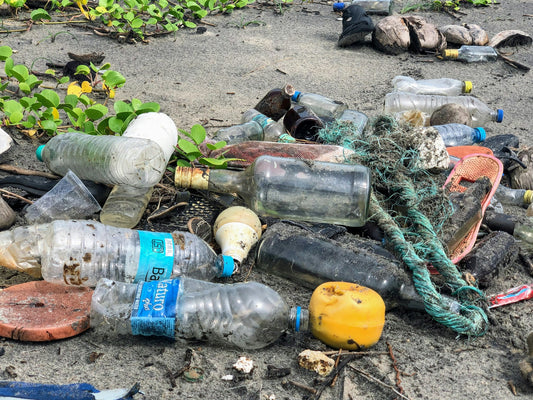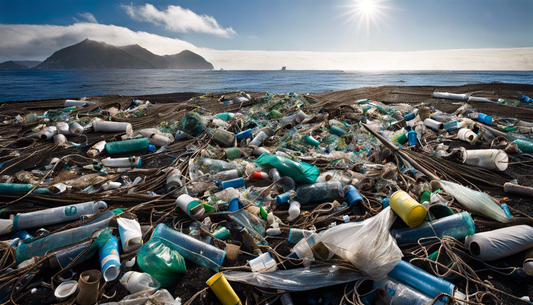Share
Plastic pollution is a crisis on a global scale that can be compared to an endless sea without borders. It's easy to blame consumers for the growth of plastic waste, when they are really the last ones in the vicious cycle of plastic pollution.
Countries' governments have a significantly higher leverage in changing pollution for the better and are critical actors in the fight against plastic waste.
One thing is certain: The plastic industry will always stretch the borders of the countries' regulations to their fullest to maximize profits.
Thus, policies have a significant effect on the amount of plastic that ends up in the oceans and landfills.
What causes plastic pollution?

Plastic pollution has many causes and it affects individuals, businesses, and governments.
Lack of regulations
One of the significant ways that communities can contribute to the problem of plastic pollution is by providing little or no regulations on plastic utilization and disposal. In many cases, nations are not equipped with strict laws to control plastic at different phases of its life cycle, and therefore, there is massive contamination. Examples for these regulations are plastic bans or incentives that subsidize sustainable business practices.
Poor waste management
In addition, there are countries where the whole waste system is not fully equipped with the right tools for plastic waste management, leading to huge volumes of plastic being landfilled or entering natural environments.
While you may think that this is only a problem of developing countries, it is not!
Take the U.S. as an example, which has a plastic recycling rate of only 4-5% and lags behind countries like India and China, who recycle 13% of their plastic waste.
Governments are responsible to provide, promote, and ultimately enforce effective waste management practices.
Corporate greed
Despite the availability of more sustainable alternatives, many firms worldwide still employ non-recyclable single-use plastics, because they are simply cheaper.
And it even goes further than that. Many companies don't shy back from flooding markets with plastic packaging, if it represents a market opportunity.
One of the most notorious examples are plastic sachets, which have been introduced by giant western consumer goods companies to exploit the consumer market in developing countries.
Encouraging this plastic dependence contributes to the immense troubles of developing countries.
Overconsumption

Fighting plastic pollution is fighting a very tricky predicament. For centuries, the world economy has been founded on (unsustainable) growth.
- Governments need to grow their Gross Domestic Products (GDP) to stay attractive for investors and stay competitive
- Companies need to grow revenues and profits to make shareholders happy
- The economy and corporate profits can only keep growing if Individuals are encouraged to consume as much as possible (side note: ever thought aout why we're actually called "Consumers"?)
Lack of education
Lack of education about plastic pollution and unawareness of the repercussions also contribute. Plastic littering can be caused by a lack of understanding about the environmental impacts of plastic garbage or apathy about recycling it in many nations.
Without significant education and awareness efforts, changing attitudes and reducing plastic usage are mammoth tasks.
Studies show that environmental education and environmental action are directly correlated. Educating our youth early and throughout their whole education journey is an essential undertaking, as we work towards a sustainable future.

Now that we know about the main causes of plastic pollution, let's dive into the main question you came for: Which countries are the most prominent plastic polluters? Some of the answers may surprise you.
Countries & Pollution
A few countries stand out for their significant contributions to the global plastic pollution crisis. Here is our list of the top polluters by total waste generated. Because this is only one perspective, we also throw in some numbers about the countries' waste per capita, and mismanaged plastic waste.
1. China
China earns the top spot on this list with 37.6 million tonnes of plastic waste produced every year. The Chinese government's recent initiatives have shown some success and drastically reduced single used plastics. China aims at controlling things like plastic production and consumption reduction. Nevertheless, the nation remains a critical provider of the worldwide plastic waste influx. Interestingly, China is far down the list, when it comes to per capita waste generation. Only around 16 kilograms per capita are generated every year. Even though China's waste management system is pretty advanced, it is responsible for 70,707 tons of plastic entering the oceans via the vast coastline.
2. United States
The U.S has long been leading the list of the world's top plastic waste producers. Today, the country comes in second with about 23 million tons of plastic waste yearly. In a fast-paced culture that values convenience over sustainability, the U.S. is struggling to manage plastic garbage, which pollutes seas and rivers. Of the plastic trash, only 4-5% are recycled and a majority is landfilled, incinerated, or shipped to other countries. The U.S. generates 120 kilograms of plastic waste per person per year, standing at one of the highest numbers in the world.
3. India
Rising plastic demand in India has led to massive plastic garbage. Insufficient trash management and little understanding of plastics' environmental impact contribute to India's significant plastic waste output. India produces 7.4 million tons of plastic garbage yearly, making it a substantial contributor to global plastic pollution. India has a poor plastic management system, polluting waterways and land. India is earning the second place in the shitlist of countries responsible for ocean plastic. 126,513 tons are dumped in the country's waterways every year. Similar to China, India's large plastic waste consumption is mainly driven by its massive population. Only 5.3 kilograms are generated per person per year.
4. Brazil
Brazil earns its place in the top 5 with 4.9 million tons of waste generated every year. The country also has a big problem with mismanaged plastic waste with around 3.3. million tons. Around 38 thousand tons of this mismanaged plastic waste ends up in the ocean. Estimates show that the average Brazilian pollutes the ocean with 16 kilograms of plastic every year. With only 23 kilograms of plastic consumed per person, this shows the massive problem the country is facing with mismanaged waste.
5. Mexico
Finally, Mexico closes our top 5 with 4 million tonnes of plastic waste produced yearly. The country has a relatively high waste collection rate, athough most of the waste is landfilled or burned. The government is investing in recycling programs and banning single use plastics. Interestingly, most of the waste in Mexico is produced in Mexico city. Although only 17% of the population lives in the region, it accounts for half of the country's waste. Mexico's yearly per capita waste is at a medium level of 32 kilograms per person.
Honorable mention: The Philippines
While the Philippines could not make our top 5 based on its yearly plastic waste generation of 2.7 million tons, the country faces huge plastic waste issues. For a few years, it has been the world's biggest ocean polluter. 356,371 tons, or around 10% of the country's plastic waste ends up in the ocean.
The Philippines have been struggling with a very peculiar issue around its "Sachet Economy". Because of the high poverty rate, the consumer market in the Philippines is flooded with tiny affordable packages of everyday products. While these packages are affordable by the average Filipino, they are easily littered and almost improssible to recycle.
Countries need to act

All countries in the world are faced with problems of plastic pollution, such as the widespread microplastics in nature and water bodies. The toxic effects of plastic can cause different health issues for both humans and animals.
The good news is that more people than ever before know about plastic pollution. Therefore, various programs have been set up to replace plastics with more environment-friendly materials and promote recycling. Countries and Companies are planning to cut down their plastic garbage all over the world, and new methods, such as Bioplastic and circular economic concepts, are being developed.
Now, we need to hold our governments, corporations, and ourselves accountable!
We need to clear up the prejudice that only developing countries are responsible for plastic pollution. By looking at per capita plastic consumption, it becomes clear that developed countries also need to take a leap forward in reducing their waste.
Through minimizing plastic purchasing, embracing recycling endeavors, and supporting legislation that advocates for sustainable methods, we can all play a part in creating a more sound and more sustainable earth for future generations.
Not only do people and corporations matter, but governments must confront the burning question of how much they contribute to plastic waste. Through strict pollution rules, broad adoption of sustainable behaviors, and funding waste management technologies, governments have the power to reduce pollution and safeguard the environment for future generations.
We hope you enjoyed this article. If you want to read more like this, make sure to check out our Blog and follow us on Instagram. If you are interested in truly sustainable products, check out our Shop.
What are your thoughts about the most polluting countries? Leave a comment below and engage in the discussion!








